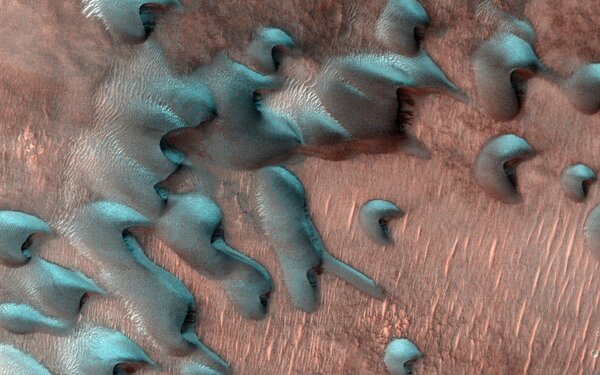When winter sets in on Mars, the planet’s landscapes are covered with snow and ice. Not much snow forms on the surface, and most of it lies on the plains. The coldest during this period of time is at the poles of the planet, where the temperature drops to -123 degrees Celsius.
Despite the fact that the winter on the Red Planet is not as snowy, and it takes much longer to come (one Martian year is equal to about two years on Earth), Mars has unique winter phenomena that scientists have been able to observe thanks to NASA robotic vehicles and the HiRISE camera .



Martian snow is formed from water ice and dry ice (carbon dioxide). Since the temperature on the planet is low and the air is rarefied, snow from water ice sublimates, that is, turns into gas even before it touches the surface. Dry ice lies on the Martian plains. Sylvain Piqueux of NASA’s Jet Propulsion Laboratory describes it this way:
“It’s enough for snowshoeing, but if you want to ski, you have to go into a crater or rocky area where snow can accumulate.”
Snow occurs only in the coldest places on Mars – at the poles, under cloud cover and at night. The problem is that the cameras on the orbiters can’t see it through the clouds, and the rovers can’t function in extreme cold. That is why the world has not yet seen a single image of falling snow. But thanks to special instruments, scientists know that this is really happening. For example, the Mars Reconnaissance Orbiter can peer through cloud cover using the Mars Climate Sounder spectrometer, which picks up light at wavelengths invisible to the human eye. Thus, snow falling on the surface of Mars was discovered. Another example is the Phoenix lander, which in 2008 detected falling snow 1,600 kilometers from the north pole of Mars.
Snowflakes on Earth are hexagonal in shape, while crystals on Mars always have four sides. Since carbon dioxide has quadrangular symmetry, dry ice snowflakes are cube-shaped. Their size is comparable to a human hair, but more often they are smaller. The most interesting thing happens at the end of winter, when all the accumulated ice begins to “melt” and sublimate into the atmosphere. At this point, it takes on bizarre and beautiful shapes that resemble spiders, Dalmatian spots, fried eggs, and even Swiss cheese. This phenomenon causes geysers to erupt as the translucent ice allows sunlight to heat the gas underneath, and that gas then rushes out.
Source: Trash Box
Charles Grill is a tech-savvy writer with over 3 years of experience in the field. He writes on a variety of technology-related topics and has a strong focus on the latest advancements in the industry. He is connected with several online news websites and is currently contributing to a technology-focused platform.







